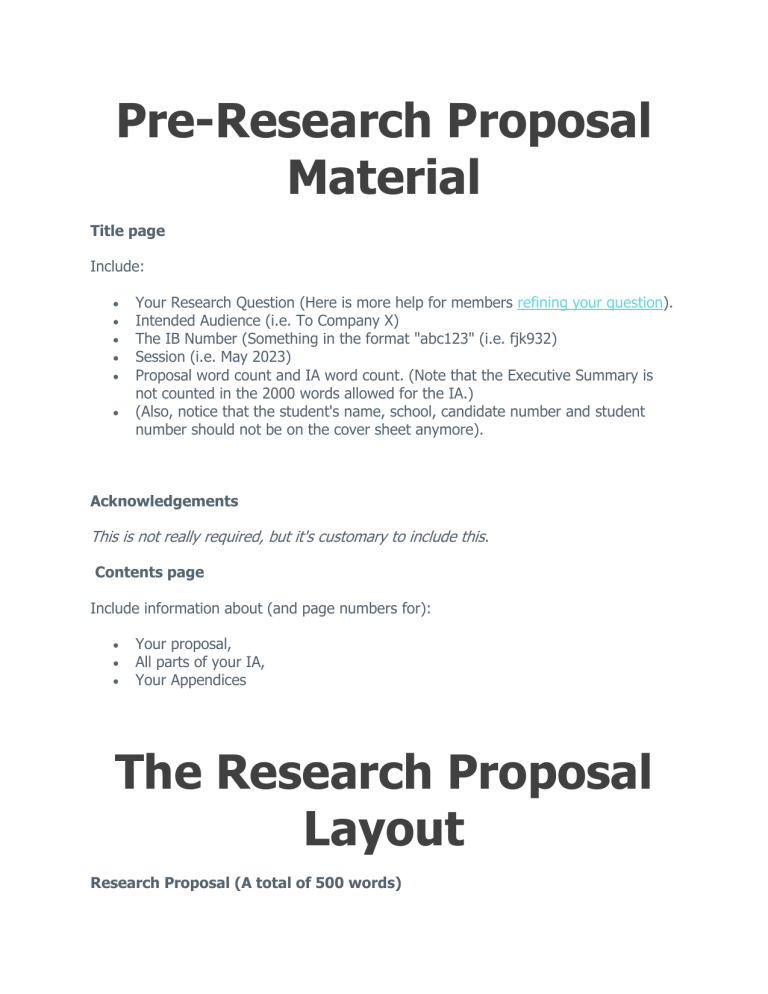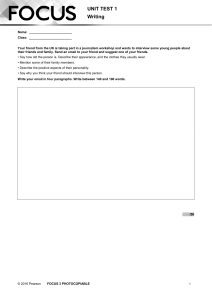
Pre-Research Proposal Material Title page Include: Your Research Question (Here is more help for members refining your question). Intended Audience (i.e. To Company X) The IB Number (Something in the format "abc123" (i.e. fjk932) Session (i.e. May 2023) Proposal word count and IA word count. (Note that the Executive Summary is not counted in the 2000 words allowed for the IA.) (Also, notice that the student's name, school, candidate number and student number should not be on the cover sheet anymore). Acknowledgements This is not really required, but it's customary to include this. Contents page Include information about (and page numbers for): Your proposal, All parts of your IA, Your Appendices The Research Proposal Layout Research Proposal (A total of 500 words) The research proposal section is written in the future tense. Include: RQ Rationale o How this RQ relates to current company priorities or challenges. o This is NOT why YOU are interested in this topic, but rather why the COMPANY has an interest in this question. For example, the company is currently focused on improving their quality of their products and your IA (and you show us this using a source) and your IA is related to increasing quality. This lets us know that your work is actually valuable. Theoretical Framework o Course sections (i.e. chapters), with specific tools listed and an explanation of how each will help you answer the RQ. o Here is detailed advice for members for what to watch out for with each of the most popular course tools. (You can join here). Methodology o The sources of primary and secondary information you will pursue, citing specific names of people you will interview (and why), as well as specific information you will focus on finding. o Include more than one source of primary data. If you can't do two interviews, you'll likely want to do something like a survey or an observation. Anticipated Difficulties. o Explain some possible problems you will likely face, the reasons for these difficulties and how you plan to deal with them. o Try to go beyond the obvious ones, such as bias and access to information. o Tell us why some of the information you need could be hard to get or unreliable. Action Plan. o Include dates and also a section where you show modifications you've made, as you completed your work. o This shows that you actually used your action plan during your IA. Also, at least one of these modifications should show that you actually learned something (or realized something related to business) and that's why you made the change. o This again shows that you were growing as a result of your work --which starts to build the case for Criterion I (Reflective Thinking). The word count for the entire proposal. The IA Layout The Internal Assessment (A total of 2000 words) Executive Summary (Abstract) (200 words --not included in the word count) From this point onward everything should be written in the past tense. For example, "First the owner was contacted to discuss possible areas of concern..." Also, include page numbers Include: Give a very quick (i.e. 1 or 2 sentence) background of the type of company and it's situation Give the RQ State the tools used Explain major primary and secondary sources used Explain your major findings, Mention a limitation of the findings. Introduction (approx. 200 words) Include: State the company name and explain what the company does (make sure this is really clear), Explain one of their current strategic priorities, Explain what you are going to research (your RQ), Explain the sections of the course which are involved. The word count for this section. Method Employed (approx. 200 words) Include: More detail about your procedure --what kinds of primary and secondary sources you used to explore your RQ Explain some of the sources of information you used (i.e. 'an interview with X and Y and a survey of Z'). Make it clear you had more than one source of primary data. (Very briefly) the benefit of using these sources. The business techniques and tools you used, and (Very briefly) the purpose of your business tools. (Watch this YouTube clip if you aren't sure about how to choose your tools, because using the right tools is essential to scoring well in your IA.) Explain how valid and reliable your data collection was. For example, how there may have been room for bias or a limited scope to your research. Explain how valid your methods of gathering data were. Mention any changes made to your IA approach as the work progressed. There should be several. Main Results and Findings (approx. 100 words) Include: A graph of some kind is recommended, A summary of your research, perhaps as a list of a few of the key facts uncovered and their primary or secondary sources. Analysis and discussion (approx. 1100 words) This is where you "J.A.M." For each tool (3 or 4 of them) include: A clear justification of the use of the theory (how it will help answer the RQ), Make sure you are using the JAM structure and that as much of your information as possible is coming through the tools (rather than in paragraph form). The analysis (i.e. the SWOT, etc), and then The mini-conclusion (linking the findings of the tool to the RQ). I recommend at least one financial tool, but this should come after your qualitative tools. In general we like to see qualitative tools (such as SWOT and PEST) come before the quantitative ones (like ratio analysis and decision trees), because the qualitative tools set the scene and provide context for the financials. Conclusions (200 words) No new data Pull your mini-conclusions together (synthesize them), make some interesting insights based on them (i.e. pros and cons, short-term vs long-term effects, possible stakeholder conflicts). This is where you really get to shine. Take time with your conclusion, so you can really emphasize everything you've discovered and how it all fits together to answer your RQ. Mention some limitations to your research. There needs to be at least one, probably two. Show you have really reflected on your work. You could discuss other information would it be very valuable to have, but which you couldn't access. You could discuss possible inaccuracies in your work and the reasons for those. This is similar to how you write your EE reflections. (Here are some tips for that). Recommendations (approx. 200 words) Include: At least 3 recommendations, At least one additional type of research (or another question to research in the future) which would help ensure the reliability of your findings. To get full marks for your recommendations section (2/2) you need to do this. (A student needs to have identified "areas for further study" for full marks here). Make sure everything you write here is supported by your conclusion. The recommendations also don't include any new information. Works Cited (No word limit) Include: At least 2 books (one of these can be the textbook) At least 2 interviews. If you can only do interview, then you'll definitely need another source of primary research --a survey, observation data, focus group data, etc). At least 4 internet sources, At least one source which shows your willingness to work hard and go beyond the minimum requirements (i.e. a trade journal, an advanced academic paper, an interview with a competitor). Appendices (No word limit) Include: Transcripts from your interviews, Additional analysis you did which didn’t fit in the body of your IA. Questionnaire results, details of the calculations you did for your financial tool, Any other interesting data which you would like to refer to in the body of your work (i.e. a market map, which you mention in the main body of your work.

